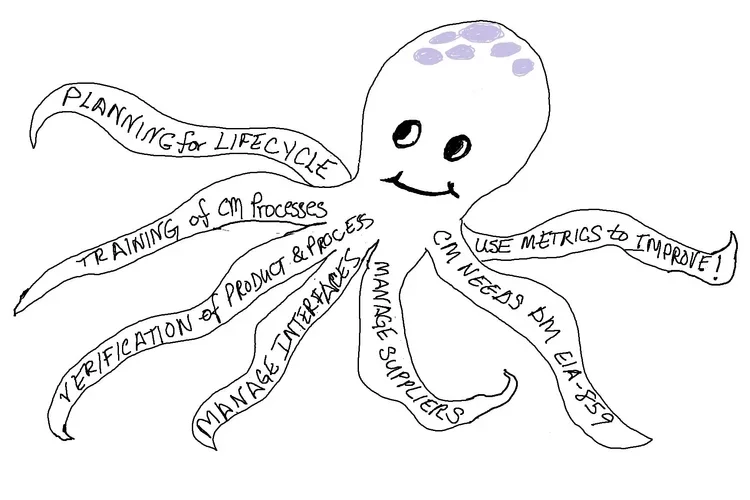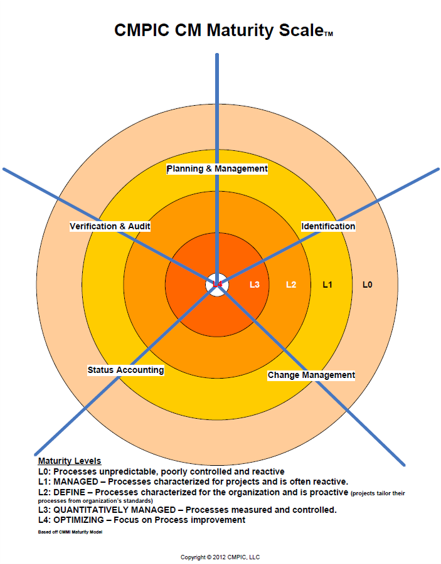The Role of Configuration Management Champions
In this month’s CMsights we examine the important yet often misunderstood role of Configuration Management Champions operating within an organization.
In a recent post we explored the obstacles to Getting Managers to Care About Configuration Management then asked readers for their own experience of making CM more important. As you can see from the below survey response chart, the top responses cited by readers can all be traced to misconceptions that managers have about the CM function but which CM Champion can remedy.
Read “Getting Managers to Care About CM” for the complete survey questions.
One of the three most-cited reasons was that the organization did not have someone on staff who had clearly been provided authority and earned respect as the CM lead to make or at least influence big decisions. This function is what many would call a CM Champion, whether that was their official job title or not. Such a person is not just a technical lead in defining, implementing, and maintaining CM but who acts as an internal champion by educating managers and promoting the benefits of CM across the enterprise.
To better understand the importance of an organization having a CM Champion we invited Lisa Fenwick, Vice President of CMstat, to discuss the role with Conrad Baranowski who himself was a CM Champion before retiring as a CM Manager at Raytheon. We asked Lisa and Conrad the following questions:
What is a CM Champion and what do they do?
Why is the role of CM Champions so important?
What are the key benefits for having a CM Champion?
Where do CM Champions come from and what skills make them effective?
What challenges should a CM Champion be prepared for and what advice do you offer?
Can you help us with a definition of what is a CM Champion and what do they do?
(Conrad) Thanks for asking me to share my experience from over four decades of work in the CM trenches for an Aerospace & Defense contractor.
Foremost, a CM Champion is a highly knowledgeable and proficient individual in the implementation and practice of Configuration Management. I can’t emphasize enough the word “practice” as it is not about the idealized theory or education in CM but its messy real-world implementation in a corporate setting with lots of conflicting requirements and even unconvinced stakeholders. So it’s not enough to just be a subject matter domain expert in CM. There are other professional skills and personality attributes equally important I hope we can get around to discussing.
In the way of actual job duties, the CM Champion is responsible for leading the effort to collect requirements, justify budgets, identify and select software solutions, define implementation road maps, educate engineers and their managers, train users, shepherd implementations, overcome obstacles, lead workflow automation, monitor performance metrics, and of course drive continuous process improvement. While that may sound like the job description of many CM Managers, they are often confined to supporting the operational execution of CM within a single contract, program, or product line with little time to do much else outside those immediate responsibilities.
I know that’s a huge list of responsibilities from experience doing all of them at one time or the other in my career, though thankfully not all at the same time! Let me also comment that CM Champions lead the effort. If CM is delegated to one person in one department doing all the work, well, the organization is likely not actually performing true CM.
(Lisa) I like that Conrad emphasizes leading the effort, and not doing the all the work, because that is often thought to be the responsibility of a CM Lead. A CM initiative cannot be successful if one person in one department, no matter how talented or how hard they work, does all the driving. CM has to be adopted with shared ownership as a corporate imperative by numerous groups across the enterprise that provide active participants to the effort. These functions can include program management, contracts, product engineering, engineering services, logistics, manufacturing, IT, data management, quality, test, service, warranty, and increasingly the regulatory compliance group.
Why the shared ownership some may ask? The days when CM was limited to engineers managing engineering changes over hardware releases are long gone given the range of products, assets, records, documentation, and processes that should be under configuration control to avoid disasters. A previous CMsights post made the case that the Deepwater Horizon accident was fundamentally a failure of management to understand all that must be synchronized under configuration control, including operator training manuals, installation records, and service documentation. When I conduct training, students are often shocked at the reach of the ‘CM Octopus’ as I like to call it, with apologies to cephalopods.
A CM Champion most certainly must be savvy at articulating a long-term vision that benefits the business. But that vision must also motivate others throughout the enterprise to buy into it now for their own short-term reasons. I’ve found that the best way to get people on board is to find out what their immediate pains are so you can answer ‘what has CM done for you lately?’ Once people see how CM is making their job better, it’s an easier sell at those levels. Yet we know that upper management listens to dollars saved from improved efficiencies. So the CM Champion has to speak a different language with managers that does not risk appearing like hard selling. To help, I recommend reading a short CMsights post on Ten Missteps to Avoid in Getting Others to Care about Configuration Management.
Finally, there is rarely a job title of ‘CM Champion’ so it never shows up on an org chart. In practice, at least historically, the role belonged to that of a senior-level professional in engineering. But as the imperative for CM grew beyond that of the product engineering organization, so did the role. CM Champions can now be found outside engineering, often at the program management level which is a good thing. I have found from my own customers that where they come from will vary by the nature of their business, customers, and products. Especially by where the biggest execution problems, performance pains, and financial risks are most likely to occur.
(Conrad) Yes, the fact that CM is getting visibility outside of engineering is a very good trend. But in my experience having a CM Champion inside of the engineering group or at least coming from an engineering background, just like you did Lisa, is a definite advantage.
Why is the role of CM Champions so important?
(Lisa) CMstat’s President Tom Tesmer often reminds customers of an aviation case study some years back when an aircraft long in production crashed carrying VIPs. The aircraft manufacturer’s CEO reacted swiftly by saying that until the source of the suspected mechanical failure was found, which was first thought to be an engineering change control issue, everyone was in quality assurance and configuration management.
Yet, that also highlights the danger that so many departments, people, and processes that create, touch, or revise data are scattered all over an organization including its supply and service chain partners. There is the risk that no one feels like they are in the lead nor has the authority to take ownership. That is why a senior executive must appoint and back CM leadership. And while that individual may not always have direct budget or reports of their own, they should be respected and supported as the executive’s appointee.
(Conrad) In my experience one of the most important functions of a champion is educating and mentoring others across all those groups. And I don’t just mean train users or data managers, but educate them in the foundations of CM as a discipline. This also includes educating their managers at a level they understand with reasons that speak to their responsibilities as to why they should care. A CM Champion should spend sufficient time educating the engineering groups and other stakeholders per the CM plan, which aids the release and change process. In A&D some of the individual engineers will eventually become Program Managers with an intrinsic appreciation for all that CM can accomplish.
I encourage both CM Champions and other key staff members to receive formal CM training from an organization such as CMPIC or certification through NDIA. While a champion can provide some of that training internally, advocating for the budget for others to receive it also comes with the job. With the velocity of organizational change, there’s a need to always be rotating personnel thru CM training programs. Many CM experts acquired our skills the hard way through successes and failures, but that was during a time when products and processes were not so complex and the risks not so huge. Employees could work for the same company their entire career, like I did, which gave them the support and time to master a discipline like CM.
(Lisa) And maybe even work on the same aircraft program for their entire career! Like some military aircraft – I’m thinking of the B-52, U-2, B-2, F-16 to name a few – have now been in service with continual refurbishment for decades and are older than we are.
I’d add that it’s important the CM champion also understand all the standards applicable to the products and environment they are managing. And the standards, like those managed by the SAE G-33 Committee I contribute to, are constantly evolving. Our global supply chain increasingly requires that international standards like those in the EU or NATO be considered as well.
How would you summarize the key benefits to an executive for having a CM Champion to help justify the role?
(Lisa) Well we all know some executives are motivated, at least on paper, by the financial upside such as a return on investment (ROI). Yet in my experience in A&D, there are many good managers who are driven to avoid pain and the Risk of Failure (ROF) in order to protect that bottom line. Minimizing risk as a benefit makes sense when you have so many things that can go wrong that will delay a new program, slow a contract deliverable, impact product performance, or even cost lives from a safety failure.
A CM Champion should have the autonomy to look across the board at different functional areas and processes to ensure that continuous improvement and optimization happens. While the exposure gained from collaborating across so many different groups can be challenging at times, it is can also be very beneficial to career advancement.
(Conrad) I have an example of that, Lisa, where I was sent to another division of the corporation for work on scoping Configuration Management and Data Management on a proposal for our customer, a government agency. I read the Statement of Work from the customer and determined what were the CM/DM requirements. I then ascertained what the current CM/DM systems were in place for their current customer. The current system was, not surprising, Excel spreadsheets.
For the proposal I needed a CM Plan, a DM Plan, and to cover other sections on CM/DM processes an efficient Status Accounting system for recording and reporting process. I then determined when the Division Director would be on site to schedule a time for a presentation of a solution. The director liked what he saw from my presentation, but after the meeting told me the financial ROI just did not justify the contract’s short-term expenditures. When the customer’s program office heard this, they were upset as they viewed CM as an investment to mitigate risks that could have a huge impact on their long-term funding as this investment allowed for his current programs to be added to the new CM system and training.
(Lisa) To sum it up I would say the top five benefits to having a CM Champion are:
Optimization of resources across functional areas involved in CM to realize ROI.
Ensure that CM Implementation goes according to schedule. The CM Lead is often tasked with doing this in their ‘free time’ which is not enough!
In organizations with multiple CM Managers, the Champion ensures standardization which leads to efficiencies.
Advising CM Leads on the establishment and maintenance of metrics so that data-based continuous improvement is possible.
Turning what was once thought of as a necessary expenditure into money-saving efficiencies and quantified risk-avoidance. The CM Lead may not have the bandwidth with all of their day-to-day responsibilities to achieve this but the CM Champion does.
Where do CM Champions come from and what skills and attributes make them effective?
(Lisa) CM Champions rarely start their careers in CM. Often they come from engineering or have engineering backgrounds but that’s not to say that someone with different experience, such as working on a manufacturing floor or in quality control, cannot be equally effective. They most certainly can. You can read about my own personal journey from engineer to CM lead in this older CMsights post.
As far as skills go, I think the most important is an awareness of the bigger ecosystem in which they are operating. A CM Champion must be forward-thinking as we’ve noted, and be able to plan for how the organization can be proactive rather than reactive to changing requirements, customer needs, technological advances, and the evolution of the product through its lifecycle. They must also be able to communicate effectively with regard to the current state of the program or product and make recommendations for future growth.
(Conrad) Most of the effective CM Champions I have met had an engineering or computer science background with a Bachelor of Science degree. After many years of work experience, with majority of that in CM, they can eventually become a CM Lead or CM Manager. Some of these will acquire the skills and reputation to be thought of as a CM Champion, especially if they receive leadership training to develop their management capabilities. Most large A&D organizations have historically been very good at identifying, training, and grooming their next generation leadership.
They have been helped by industry associations that include DAU, CMPIC, IpX, and the National Defense Industrial Association. NDIA believes in investing in the professional growth of personnel and provides professional development courses to encourage improvement in management. If you are an NDIA-certified CM manager, then you will have an excellent understanding of all the required specifications applicable to CM since they were part of your study and test requirements. However, with the implementation of Acquisition Reform and the ISO Initiatives, the application of CM has changed. No longer will ‘the how to’ documents like Mil-Std-480 or Mil-Std-973 be applied to new contracts, but to understand these specifications and utilize the information contained will still enhance one’s competency.
(Lisa) Many CM tool providers and CM consultancies also offer training that is not software tool dependent. As example, CMstat offers an Introduction to Configuration Management training which exposes participants to the fundamentals, objectives and best practices of Configuration Management which then can promote better understanding of CM and the CM Champion role. In our implementations we also find it necessary to provide users, managers, and consumers of CM data with a common ‘language’ of CM so that the role of the CM champion can be better utilized.
This August I will be co-leading a short course at CMPIC’s CM Trends on Functional Configuration Audits (FCA) and Physical Configuration Audits (PCA). As I’ve researched the Verification and Audit functions, I’m repeatedly thinking to myself that the audit functions themselves can be a full-time job, which brings up another point. The CM Champion is also a support system for an organization’s Configuration Managers. In this case, a CM Champion helps guide the process and make sure the sufficient resources are defined and made available for audit preparation, conduct, and follow-up. They may also advise during the planning phase to ensure that the purpose of the audit is fulfilled while not overburdening with unnecessary tasks or validations.
What challenges should a CM Champion be prepared for encountering and what final advice would you offer?
(Conrad) The amount of budget needed to implement and maintain CM capabilities and competencies is not small. Yet, the cost and risk of not doing so are even greater as we can read about in delays of new programs and product failures that make the industry news. Preparing the financial analysis to justify all this is no small matter, and fighting for budget among all the other possible expenditures is going to be necessary.
You also need to be ready on short notice to present and recommend CM capabilities for a new contract win or even in the original bid package. As example, coming up with a CM Plan from scratch that meets the specific requirements of a new contract is not trivial. And while it helps to have a CM Plan template, I have never seen a generic plan that can be force fit into a new product line or program office without substantial customization.
Never give up in trying to constantly improve your organization’s overall CM maturity, core competencies, staff readiness and supporting software tools. CMstat had a post some time ago about CM Maturity Levels which I recommend reading.
Example CM Maturity Scale From CMPIC
Finally, don’t let the fact that everything may be going fine to lull you into a false sense of security. Especially with the rate of changes as I have witnessed in decades of work in A&D program CM. What made you successful and got you comfortable today is not going to be sufficient to keep you there in the future.
(Lisa) I think what Conrad noted about obtaining the all the resources needed is certainly a challenge. To help with that, furthering the understanding of CM is an ongoing responsibility of CM’ers in all areas and will continue to be a necessary part of the champion role. They are uniquely positioned to advocate for proper CM resources.
I know that many Configuration Data Managers I’ve worked with would have benefitted greatly from having a Champion in place to help them as they are not always the same person. The lack of knowledge of what is truly involved in CM has many of them wearing multiple hats. Especially knowing that performing ‘good CM’ involves concurrent tasks in Planning and Management, Identification, Change Management, Status Accounting, and Verification and Audits, Data Management, Training, and Process Improvements.
To profit from the benefits of CM, there are so many wide-reaching tasks and planning to be done, it is best as a team effort. Knowing when to be a good team player and when to lead a team are career skills that are not easy to acquire while working full time from home on zoom meetings.
Thanks to Lisa Fenwick and Conrad Baranowski for contributing to this insightful discussion about CM Champions. Learn more about CMstat’s consulting and training services HERE.
Now a question for readers: what background and skills do you think make for an effective CM Champion? Let us know by joining the discussion about CM Champions on CMstat’s LinkedIn page.
Receive CMsights
Subscribe to CMsights News for the latest updates from CMstat on Configuration Management, Data Management, EPOCH CM, and EPOCH DM.
Request a Demo
See how EPOCH CM and EPOCH DM support industry standards and best practices in Configuration Management and Data Management.







